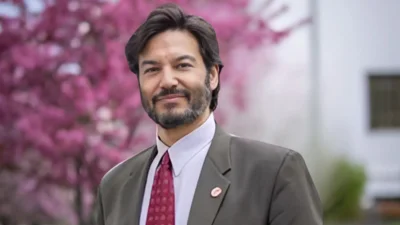President Jonathan Koppell | Official website of Montclair State University
President Jonathan Koppell | Official website of Montclair State University
Department collaborations at Montclair State University have resulted in a vibrant exhibition that merges art and science, specifically fusing the fields of neuroscience and artistic expression.
Assistant Professor of Biology Thomas Mueller from the College of Science and Mathematics collaborated with Professor of Art and Design Cathy Bebout, head of printmaking. Mueller, who studies human affective disorders using zebrafish as a research model, emphasized the genetic similarities between zebrafish and humans, stating, "Zebrafish is really a very important genetic model organism. It shares around 70% of genetic similarities with humans and about 80% of the diseased genes that you find in humans have a counterpart in zebrafish."
Following Mueller’s presentation, students created artwork inspired by scientific imagery. Adjunct Art Professor Bridget McGuire noted, "There’s a relationship between this collaborative way of working and a scientific process. It’s experimental. It was an interesting investigation and felt like a research collaboration."
Visual Communication Design major Lindsey Scheier explored the abstract nature of emotion: “Dr. Mueller’s presentation made me think about abstraction, and how to convey fear through abstraction. It felt too literal to print a fish, so I tried to explore what the shapes and colors of fear might feel like, especially for such a tiny creature.”
The project, as explained by Bebout, uses art and science as educational tools: “This project uses art and science as a teaching tool, fostering dialogue and learning between disciplines while demonstrating the arts’ power to drive engagement and social change.”
Under Montclair faculty guidance, the students turned scientific data into artwork, now exhibited at Finley Gallery. Bebout elaborated, “It shows up in the brain as color, so that’s why you see all this brilliant color on display."
Students' art emerged from "print jams," collaborative printmaking sessions. The exhibition, "Zebrafish and the Art of Fear: A Creative Inquiry into Memory and Emotion," presents both abstract and literal interpretations. The month-long event included discussions and featured scientists like Koichi Kawakami and Joseph E. LeDoux.
Art Professor Sharon Lindenfeld commented on the process, "You learn from what you just printed and then you try something different in the next one, much like a scientific process."
The collaboration was a novel experience for many. McGuire stated, “I’ve never worked collaboratively like this, so it was such a cool experience." Plans for future interdisciplinary efforts are underway. “This is the startup of a major endeavor and future collaborations,” Mueller said.
Bebout remarked on the broader impact: “The art will help to promote science and get people’s attention, so they want to know more.” Mueller added, "And make neuroscience accessible to the wider public and maybe inspire students in the arts and high school students to pursue a career in these scientific sciences or in the arts."
Scheier added her perspective, "I believe art and science are closely connected and more focus should be placed on their collaboration."


 Alerts Sign-up
Alerts Sign-up